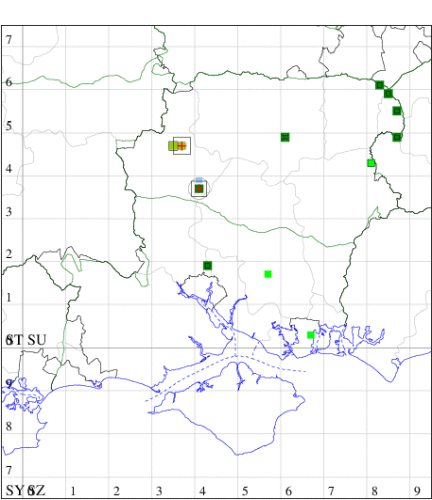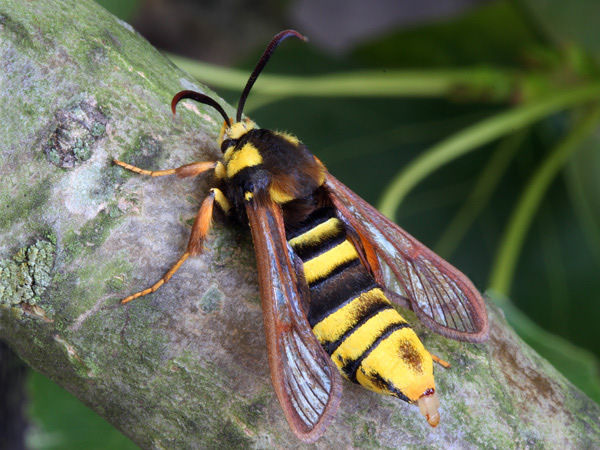Hornet Moth
Sesia apiformis
Checklist Number52.002 [B&F: 0370]
Verification
Record will require further evidence, at least a good photograph, unless CMR is aware recorder has confidence in identification
Nationally scarce (Nb) in open areas with scattered trees in central and southern England, though also recorded from Durham and north and south Wales; local in Ireland with scattered records from a few eastern and southern counties (MBGBI Vol 2). In Hampshire known from only a handful of sites, notably at Chilbolton, where known for many years. Not recorded from the Isle of Wight to date. Wingspan 33-46 mm. Day-flying. Mainly recorded in the larval form, but the early stages are difficult to find during the winter months and the species' true distribution remains largely unknown; the use of the HOR pheromone lure is expanding our knowledge of the true distribution of this spectacular insect. Distinguished from the similar Lunar Hornet Moth by the yellow head and tegulae.
Larva feeds within wood of Black Poplar and other poplars, over-wintering two or three times.


The abundance in each month is indicated as follows:
 No records
No records Very occasional
Very occasional Irregular
Irregular Uncommon
Uncommon Off-peak, but not unusual
Off-peak, but not unusual Off-peak, but not unusual
Off-peak, but not unusual Main flight time
Main flight time| J | F | M | A | M | J | J | A | S | O | N | D | |
|---|---|---|---|---|---|---|---|---|---|---|---|---|
| Adult |  |  |  |  |  |  |  |  |  |  |  |  |
| Larval |  |  |  |  |  |  |  |  |  |  |  |  |
Records by week (adult)
Records by week (larval)
VC11 South Hampshire
| Site | Date | Quantity | Recorder | Stage |
|---|---|---|---|---|
| Hilsea, Portsmouth (SU60) | 21/02/2008 | - | J R Langmaid, P H Sterling, I R Thirlwell | Emergence holes |
| The Moors NR, Bishop's Waltham (SU51) | 12/10/2008 | - | Phil Budd | Nest |
| Stanford in the Vale (SU41) | 28/06/2020 | one | Simon Woddy | Adult |
| Winchester (SU42) | 06/06/2024 | one | Barrie Roberts | Adult |
VC12 North Hampshire
| Site | Date | Quantity | Recorder | Stage |
|---|---|---|---|---|
| Chilbolton (SU43) | 29/06/1966 | one | D W H Ffennell | Adult |
| Chilbolton (SU43) | 11/07/1966 | one | D W H Ffennell | Adult |
| Chilbolton (SU43) | 1982 | four | E C L Simson | Adult |
| Chilbolton (SU43) | 01/07/1985 | - | Tony Pickles | Pupal |
| Chilbolton (SU43) | 19/04/1986 | - | J R Langmaid, E C Pelham-Clinton, D H Sterling | Emergence holes |
| Chilbolton (SU43) | 01/06/1989 | one | Tony Pickles | Larval |
| Forest Lodge (SU84) | 29/06/2008 | two | Tony Davis | Exuvia |
| Chilbolton (SU43) | 22/02/2010 | - | David G Green | Larval |
| Chilbolton (SU43) | 03/07/2010 | two | David G Green | Pupal |
| Andover (SU34) | 22/05/2019 | 12 | Graeme Davis | Mine (vacated) |
| Andover (SU34) | 09/06/2019 | one | Graeme Davis | Case |
| Andover (SU34) | 09/06/2019 | one | Graeme Davis | Adult |
| Andover (SU34) | 03/07/2019 | three | Graeme Davis | Adult |
| Basingstoke (SU64) | 09/06/2022 | - | via iNaturalist | Adult |
| Basingstoke (SU64) | 09/06/2022 | one | Sean Pyman | Adult |
| Chilbolton (SU43) | 18/06/2022 | one | Nigel R Jones | Adult |
| Farnborough (SU85) | 22/06/2022 | one | Richard Seargent | Adult |
| Tice's Meadow, Aldershot (SU84) | 02/07/2022 | one | Sean Foote | Adult |
| Hawley Meadows (SU85) | 10/07/2022 | one | Ben Dale | Adult |
| Blackwater (SU86) | 11/07/2022 | one | Tom Forster | Adult |
| Hawley Meadows (SU85) | 02/07/2023 | three | Ben Dale | Adult |







